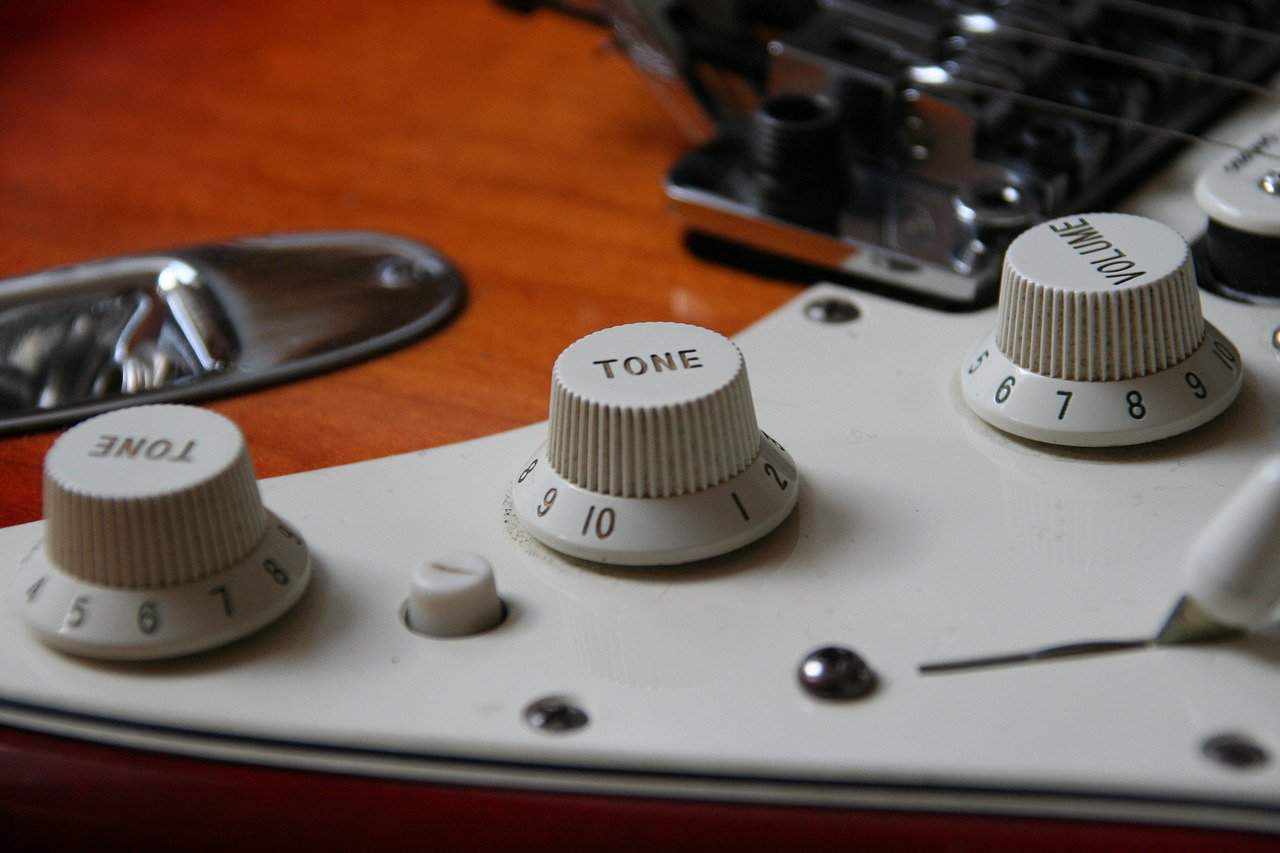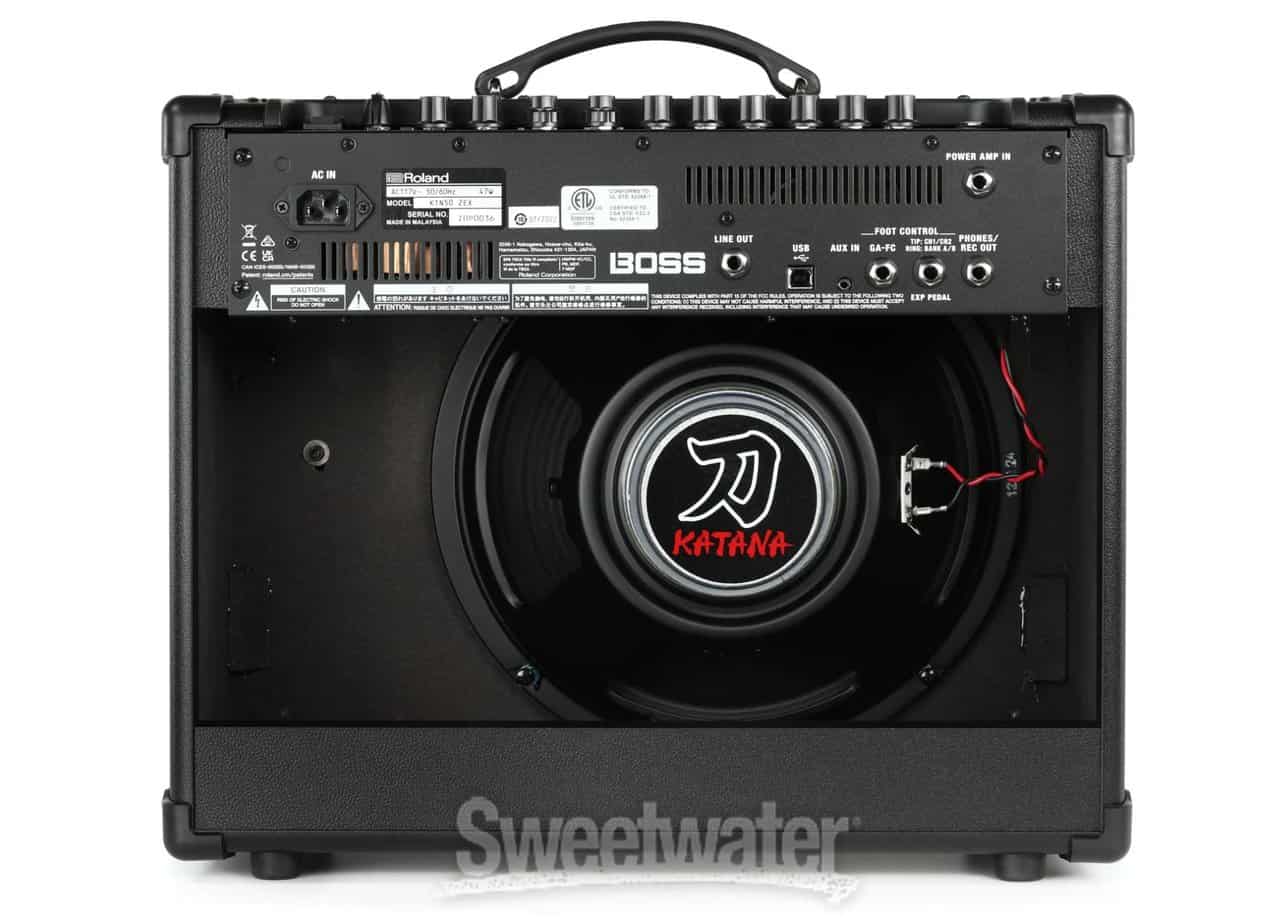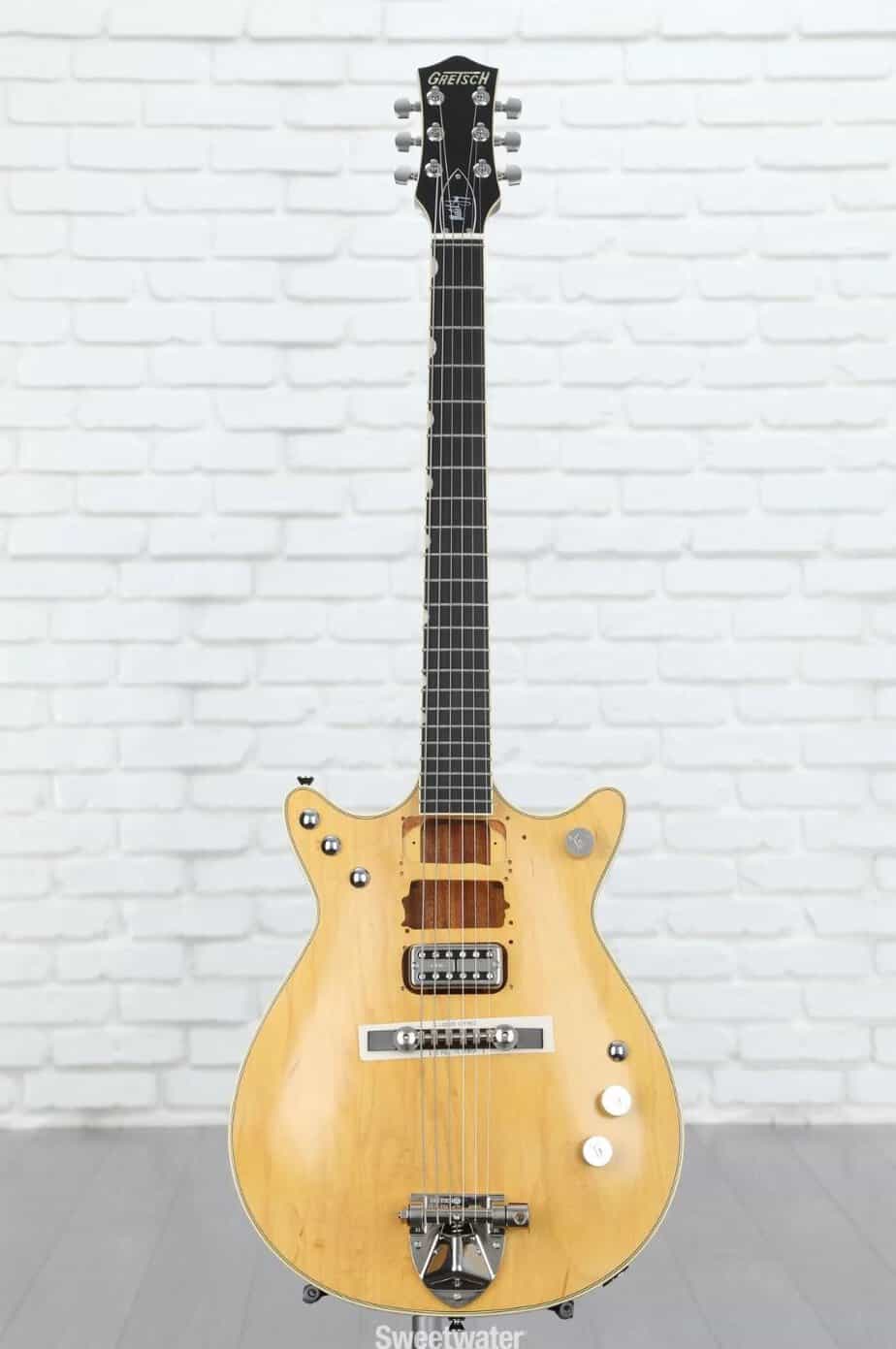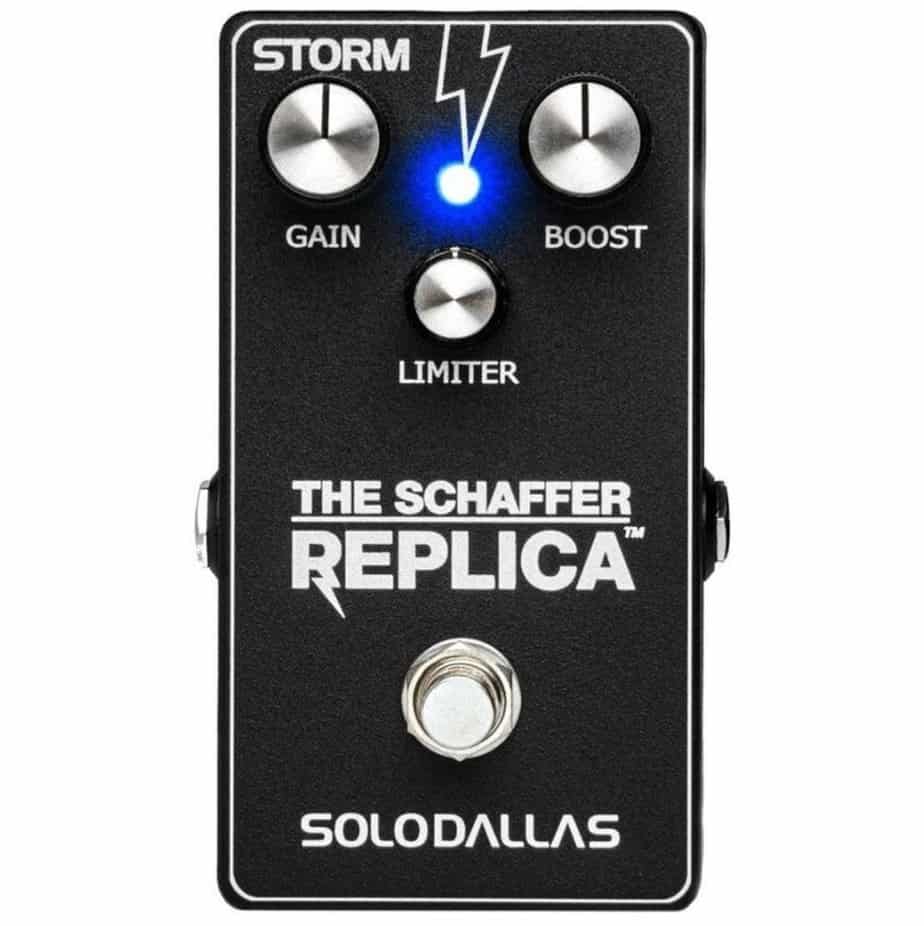When I was 14 years old, my uncle took me to an AC/DC concert in Lisbon, Portugal. I was already a fan of their music as I was getting into guitar and rock & roll bands from the ’70s, but that night changed my life completely!
I had never been to such a big concert before, and seeing them perform right in front of my eyes left me speechless.
In the following months, I was obsessed with their sound and the sheer power that I could feel coming out of their rig. I obviously didn’t have the resources to buy the same gear as Angus and Malcolm Young were using, but that led me to find alternatives and explore my current guitar, amplifier, and pedals to the fullest.
In this AC/DC Amplifier Settings Guide, we are going to go over what makes Angus’ and Malcolm’s guitar sound so raw, powerful, and addictive so that you can get closer to their legendary tone!
Bottom Line Up Front
When dialing your amplifier for an AC/DC tone, you’re generally going to want a nice crunchy sound, that is not heavily distorted but has enough grit and sustain for classic rock. If you’re going for Angus’ tone, you should increase the Gain a little bit more than Malcolm’s rhythm guitar tone.
A good starting point would be a guitar with humbuckers such as an SG and a British-style amp such as a Marshall with a dirty channel, or an overdrive pedal like the BOSS OD-1 or the JHS Charlie Brown.
As for the amp settings, start with the Bass around 5, Mids around 6.5, Treble around 7, and set the Volume and Gain so that you have a solid overdrive that isn’t overly compressed.
AC/DC’s Amplifier Settings
99% of the time you think of AC/DC’s guitar tones, you’re thinking about overdriven guitars, so we’re already starting at either a loud tube amp that is delivering natural crunch and compression, an amp with master volume and a gain control, an overdrive pedal, or even a combination of these elements.
To get closer to AC/DC’s guitar tone, use these settings as your starting point:
- Volume: 6
- Gain: 7
- Bass: 5
- Middle: 6
- Treble: 6
- Presence: 7
- Reverb: 3
Depending on your setup, some of these settings might need a little tweaking. For instance, if your amp has a lot of headroom or isn’t driven by tubes, maybe having the Volume knob at 6 doesn’t cause it to break up, which is the intention here.
If your amp does not have a Gain knob, you might be able to compensate for that by using a nice overdrive pedal such as the ones recommended later in this guide. Some amplifiers don’t have Reverb (like Angus’ Marshall JTM45’s), so you can use a pedal such as the TC Electronic Hall of Fame for just a touch of space in your tone.
A good practice is to have your guitar’s volume knob at 10 and try to go for your dirtiest lead tone, and then explore how that sound changes as you roll the volume back on the guitar. Crafting your tone like this allows you to jump between lead and rhythm sounds with a small adjustment on the guitar, which is what many professional guitarists do.
What Defines a Guitar’s Tone?

Even though the correct amplifier settings are crucial to achieving a desirable tone, they are just one piece of a much larger puzzle than we need to account for.
If you’re trying to get closer to AC/DC’s guitar sound, you have to investigate what they are using and how they make the most out of their gear, so that you can adapt yours to get as close as possible to theirs.
Here are a few things that play a significant role in defining a guitar’s tone:
Electric Guitar Type and Model
One of my favorite aspects of being a guitar player is figuring out the right guitar for the job. If I’m playing a jazz gig with standards from artists like John Coltrane and Wayne Shorter, I’m not taking my Stratocaster.
It is a marvelous guitar and it would still allow me to play, but I’d get a much more satisfying sound out of my hollow-body guitar with thick strings.
If you’re going for an AC/DC type of tone, you should at least grab a guitar with a pair of humbucking pickups. A solid body would be optimal because of the reduced risk of feedback.
Guitar’s Pickups
Humbuckers, P90s, Single-coils, Gold-foils, Filtertrons… There are many different types of pickups and while some might be more versatile than others, they all have their characteristic sound. Guitars like Stratocasters and Telecasters tend to have single coil pickups (not 100% of the time), and Gibson guitars like the SG, Les Paul, Explorer, or Flying V usually feature a pair of humbuckers.
These higher-output pickups will get you closer to an AC/DC-inspired tone since they are the same as Angus Young uses. Any models inspired by Gibson’s PAF pickups will be a great choice for this endeavor.
Amplifier Type and Model

As you start exploring what amplifiers are available at most music stores, you might be a bit overwhelmed.
Solid state amps, tube amps, and now you can even get away with no amp if you’re using a pedal like the Strymon Iridium or the Walrus ACS1 which are amp simulators. Amp simulators such as the ones developed by Neural DSP are becoming pretty popular too.
If you want to get a good AC/DC tone, my recommendation is to get a British tube amp such as a Marshall that has a decent overdrive channel. You can also use an overdrive pedal to get all your dirty tones or to push the amp harder and EQ it through the pedal as well.
Amplifier Settings
Having your amplifier set properly is extremely important if you want to sound good. The same amp will sound different when paired with different guitars and pedals, so you need to account for that too. When I’m trying out an amp for the first time, I like to set everything at noon and work from there.
If it sounds very boomy and muddy, I cut some of the bass frequencies. To open it up and give it a bit more body, I boost the mids a little. If it sounds very harsh and brittle, I’ll adjust the Treble and maybe the Gain.
Playing around while you make these adjustments is also very useful (think of it as a chef tasting the food as he cooks and seasons it). It is wise to play with different degrees of intensity, seeing how the guitar’s volume knob affects the amp with those settings, etc.
My rule of thumb is to decrease the frequencies I think I have too much of before boosting anything else. For instance, I’m more likely to decrease the Treble to make my sound a bit darker than I am to increase the Bass.
Effect Pedals

Although this is not very relevant when discussing an AC/DC tone (simply because they mostly just plug their guitars straight into their amplifiers), effect pedals play a very big role in a guitar’s tone when they are engaged.
In my case, I usually play a clean or on the edge of breakup tube amplifier such as a Fender ’68 Custom Deluxe Reverb and pair it with my favorite overdrive and distortion pedals such as the Analogman King of Tone and the JHS Angry Charlie.
Even though AC/DC are not known for using Fender amps, I can still get close to their sound if I adjust everything properly.
Other pedals like time-based effects and modulation can be indispensable to nail certain guitarists’ tones, but with AC/DC, I’d say you either don’t need any, or you might just need a decent overdrive and a reverb pedal (if your amplifier does not have it).
The Player – Technique, Dynamics, Sensitivity
Obviously, no list about what makes a good guitar tone would be complete without mentioning the most important piece of the puzzle – the guitarist!
I am 100% sure that Angus Young would sound more like himself playing through my gear than if I were to play through his guitars and amplifiers from the old AC/DC recordings, and this is because of his touch, picking technique, vibrato, among other things.
If you want to sound more like one of your guitar idols, it is imperative to listen to them with as much attention as possible and think about how you can adapt or change your playing style to get closer to theirs.
As you do this for a long time, you will start to understand how they think and approach certain situations, which in my opinion has much more weight than your guitar’s pickups or amplifier.
AC/DC’s Guitar Tone – What Contributes to Their Sound

Fortunately, AC/DC is not a band in which the guitarists are known for having extremely complex setups with multiple amplifiers and large, complicated pedalboards. The core ingredients to their sound are Marshall amplifiers such as the JTM45 (Plexi), and as for the guitars, a Gibson SG (Angus Young), a Gretsch Jet Firebird (Malcolm Young), and that is pretty much it.
Marshall Plexi amps (JTM45, JTM50, JMP50, Super Lead) don’t have a lot of gain, but since they crank their volumes when performing and recording, they can get that classic rock crunch that we’ve all grown to love without using any pedals.
In the speaker department, the Australian guitar duo tends to go with models such as the Celestion G12H 30W, Celestion Vintage 30W, and Celestion G12M 25W, in Marshall 4×12 cabinets.
Since this might be tricky to replicate at home, you can get away with a less powerful amp that has a decent overdrive channel, or a clean amp with a good overdrive pedal such as the JHS Charlie Brown, which is meant to be a JTM45 in a box.
As for the guitar, a decent solid-body electric guitar with a pair of humbuckers should do the trick, but if you can get a Gibson SG with vintage-oriented specs like a ’61 Reissue, it will get you closer to the sound you’re looking for.
AC/DC’s Guitar Amplifiers and Modern-Day Suggestions
AC/DC’s main guitar amplifier (especially for Angus Young) is the Marshall JTM45, also known as a Marshall Plexi. This is none other than Marshall’s first amplifier model ever, inspired by the Fender Bassman.
If you’re after Angus’ tone and your budget is enough for this amplifier, there are reissues that you can buy today, but keep in mind that they are extremely loud! Most of the modern-day Plexi amps still do not have a Master volume, but even if they do, they really need to be played at a loud volume to get the sound you’re looking for.
Other amplifiers that have been used by AC/DC are:
- Marshall JTM50
- Marshall JMP50
- Marshall Super Lead
- Wizard Modern Classic Amps (built by Rick St. Pierre, an amp tech that worked for AC/DC in the past)
Here are a few amp suggestions that will put you on the right track without having to make your neighbors angrier than ever from the noise:
Marshall 1974X 18W Combo

The Marshall 1974X is often called a “pint-sized Bluesbreaker”. With just one 12″ speaker and 18W of power, you can obtain a gritty and full-bodied rock & roll sound without having to engage any pedals. It isn’t cheap, but if you want a legitimate, faithful reproduction of one of the amplifiers that turned people’s heads when it was originally released, the 1974X should be on your amp bucket list.
Marshall ORI50C Origin Combo

The Origin Series is a modern take on the tube amps that every guitarist loves. It features a Master Volume, FX Loop, switchable power modes, and a foot-switchable gain boost.
These kinds of options were never available on old-school Marshall amplifiers, but they can come in handy when you’re trying to replicate a guitar legend’s tone in a smaller setting such as the bedroom or a small rehearsal room.
BOSS Katana 50 MkII Combo

I have included the BOSS Katana 50 MkII in this short list of suggestions because it is one of the best quality/price ratio amps that I have found over the last few years.
If you value reliability and a lightweight amp, this is also a great choice due to being powered by transistors instead of tubes. It is less prone to breaking down, and it has a vast array of sonic possibilities in all genres.
It has decent clean sounds, good overdrive and even though I’m not a huge fan of the distortion, it is still usable. You can tweak everything even more if you use their software.
AC/DC’s Guitars and Modern-Day Suggestions
Angus Young
Angus Young has always been a big fan of the Gibson SG, and he’s typically one of the first players who comes to mind when people talk about this guitar.
He has bought several of them throughout his career, but one of his main guitars is the 1970/71 Gibson SG Standard. It was his first guitar, and he used it on AC/DC’s first studio records. This one features a walnut finish and a Lyre Maestro tailpiece, often called “vibrola”.
Here are a couple of guitar suggestions to get you started:
Gibson Angus Young Signature SG

If you’re trying to get closer to Angus Young’s guitar tone, one of the most logical options is to get his signature SG, made by Gibson. It is built to his exact specifications and it is a faithful reproduction of one of his most famous guitars.
However, it is also a bit pricey, and you can also get amazing sounds from Standard models such as the ’61 Reissue that Gibson currently sells.
Epiphone SG Standard

Epiphone has been building affordable versions of Gibson’s famous models for years. If you don’t want to spend more than 1/2k dollars on a guitar but you still want the classic looks that the SG offers, then this might just be the guitar for you.
Featuring a mahogany body, ’60s mahogany SlimTaper Neck (not the huge baseball neck some SG’s have), Alnico Classic PRO pickups, and CTS electronics, you can get all kinds of classic rock sounds without busting the bank!
Malcolm Young
Malcolm Young has also shown very specific tastes. Even though he could have experimented with as many guitars as he wanted, he played the same guitar for pretty much his whole career. We are talking about a 1963 Gretsch G6131 Jet Firebird that was nicknamed “The Beast”. Let’s take a look at a couple of guitars that would be interesting choices for a Malcolm Young kind of tone.
Gretsch Professional G6131-MY Malcolm Young Signature Jet

If your main objective is getting as close as possible to Malcolm’s tone, Gretsch sells a signature model that is inspired by his legendary guitar nicknamed “The Beast”. I wouldn’t say this is the most versatile guitar ever since it only has one pickup (just like Malcom’s, which has the neck and middle pickups removed), but it looks and sounds like pure rock & roll.
The price tag isn’t the friendliest either, so I’d only get this guitar if I was completely committed to Malcolm’s tone.
Gretsch G2210 Streamliner Junior Jet Club

If you’re looking for an affordable option, the Gretsch G2210 Streamliner Junior Jet Club is one of your best bets. Although it isn’t a double-cut model like Malcolm’s, this guitar comes equipped with a pair of Broad’Tron pickups, which will nudge you in the right direction.
Other interesting features of this guitar include a wraparound bridge, a nato neck with a laurel fretboard, and a lightweight nato body. It comes in 4 finishes, but my favorite is definitely the Imperial Stain.
AC/DC’s Effects and Modern-Day Suggestions
Neither of AC/DC’s guitarists is known for using any pedals, they simply plug their guitars into their amplifiers and turn them up loud enough so that they overdrive naturally.
Since this is not always possible for the average guitar player because of noise concerns, some pedals can help you achieve a similar tone without shaking the foundations of your house! Here are some of my favorite pedals for the sound we’re looking for:
JHS Charlie Brown

The Charlie Brown is meant to capture the sound and feel of a Marshall JTM45 in a pedal, so it is trying to give you the same base that AC/DC has used for years to craft their guitar tones.
It works well with humbuckers and single coils, the 3-band EQ is responsive, and it can be used for various purposes, not just rock & roll overdrive. I’ve used mine as a clean boost, and it also works great when stacked with other pedals like the Analogman King of Tone or the Ibanez TS-9.
SoloDallas The Schaffer Replica Storm

SoloDallas is responsible for the release of The Schaffer Replica EX Tower, a revival of a piece of equipment that Angus Young and many other legendary guitarists relied on for singing sustain, compression, limiting, boost, and much more.
Later, they released the Storm Pedal, a pedalboard-friendly version of this valuable secret weapon. It features a 100% analog signal path that is identical to the Tower version in a more affordable and compact enclosure.
Marshall Bluesbreaker Pedal

Marshall has recently reissued a line of pedals that was becoming difficult to obtain due to their rarity and price. The Bluesbreaker is a pedal voiced after the 1962 Bluesbreaker amplifier.
While it isn’t the amp that AC/DC is known for using, it can deliver legitimate classic rock tones, a lot of variety from just one Tone knob, and enough Gain on tap for rhythm and solos, although it sounds great when stacked with a low gain overdrive for added sustain.
FAQs
Question: What amplifiers does AC/DC use?
Answer: Since their early days, AC/DC have extensively used Marshall amplifiers, especially Plexis. This includes models such as the JTM45, JTM50, JMP50, and the Super Lead.
These are not high-gain amplifiers, but playing them at very high volumes makes them produce the overdriven tone that Angus and Malcolm Young are known for.
Question: What pedals sound like Angus Young’s guitar tone?
Answer: While Angus Young himself is not known for using guitar pedals, there are a few overdrives that can help you get pretty close to his tone. A few examples of these would be the Marshall Bluesbreaker, JHS Charlie Brown, and the Schaffer Replica by SoloDallas.
Question: What would be a good guitar to get close to AC/DC’s tone?
Answer: Angus Young has always used Gibson SG guitars throughout his career. If that is within your budget, a model such as the ’61 Reissue or even his signature model would be a great choice.
Epiphone also makes a few cheaper versions of the SG. For Malcolm’s tone, a nice affordable choice would be a Gretsch G2210 Streamliner Junior Jet Club, due to its Broad’Tron pickups.
AC/DC Amp Settings Guide: Final Thoughts
It is clear by now that having a properly set up amplifier is important if you want to nail a certain guitarist’s sound. However, there are many things to take into account other than the amp’s settings, such as the amp itself, the guitar, and the pickups.
For AC/DC’s tone, a good starting point would be a solid body guitar such as an SG with humbuckers paired with a British amp such as a Marshall with a good dirty channel. A quality overdrive pedal such as the SoloDallas Schaffer Replica or the JHS Charlie Brown can also yield very satisfying results, especially if you can’t play at high volumes frequently.
Start with the Bass at 5, Middle at 6/7, Treble at 6/7, and adjust your Volume and Gain to get a crunchy sound that has decent sustain without sounding like a heavy metal tone. Use an overdrive pedal like the Marshall Bluesbreaker if your amp does not have a dirty channel.
As always, listening is crucial, so make sure that you spend enough time listening to AC/DC’s guitar tones closely, and adjust your amp’s settings to have similar levels of saturation (gain), enough body, and definition while making sure that it still cuts through the mix easily and has enough sustain for lead and rhythm playing.
- My Supro Black Magick Reverb Head + 2×12 Cab Review – A Trip to the 70’s Rock n’ Roll Spirit - April 17, 2024
- Everlong Amp Settings Guide - January 29, 2024
- Takamine vs Taylor Brand Comparison - January 19, 2024

